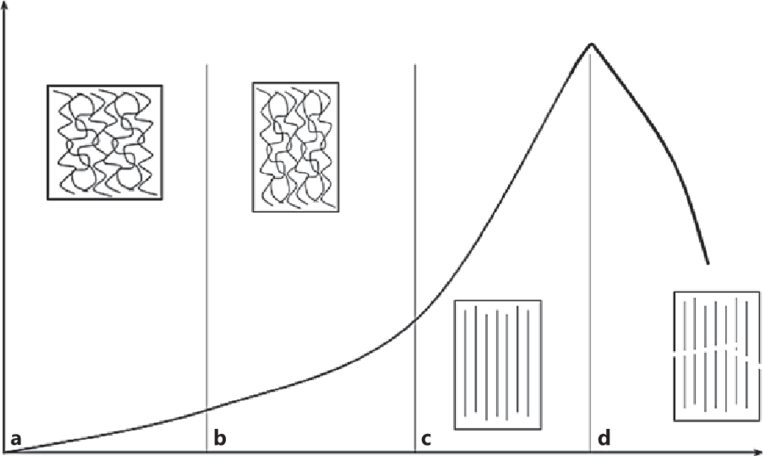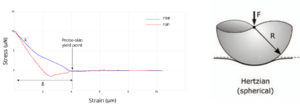CONTEXT
Skin is made up of different layers (epidermis, dermis, hypodermis) and is regularly exposed to all kind of stress. As those layers have different composition and thickness, each of them has a specific mechanical role.
Skin resistance to stress is mostly due to elastin and collagen fibers. Skin being composed by 14 collagen types and 3 elastins, this diversity makes complicated to understand skin behaviour.
The skin response to stress is characterized by a stress-strain curve and its evolution is correlated to the role of each fibers groups.

Figure 1 : Sress-strain curve
Elastic modulus (or Young modulus) is intrinsic value that describes an object’s resistance to being deformed elastically while an external force is applied to it.
Defined by a constant relating indentation force to anticipated deformation of a very elastic object as skin, elastic modulus is expressed in Pascals (Pa).
Elastic modulus is usually measured in BioMechanics to characterize accurately skin mechanical properties. In this context, Biomechanics uses tissue stiffness to investigate structural properties.
Why stiffness ? Rigidity is measured thanks to stiffness constant (k) which is the main measure to evaluate skin resistance to an elastic deformation. That’s why more a cutaneous sample is stiff, more we have to apply an important deformation to obtain a significant deviation to the initial position.

Figure 2 : Study of the stiffness applied on skin.
Then, the stiffness constant is defined by :
- (A) is the cross-sectional area
- (L) is the length of the element
- (E) is the elastic modulus

WHY AFM ?
Atomic Force Microscopy (AFM) allows us to characterize elastic properties of biological samples as skin, before and after treatments with active ingredients or finished products. A cantilever with a spherical tip with a radius of curvature of several μm (indentation-force curve) is used to measure the stiffness constant (k) in contact with the skin sample.
Elastic modulus is defined thanks to Hertz Model that is based on sample contact with a sphere.

Elastic modulus is calculated with the formula where :
- (F) is the force exerted on an object under tension
- (E) is the Young’s modulus (Elastic modulus)
- (R) is the radius curvature of the AFM tip
- (δ) is the tensile strength or indentation applied to the sample
- (v) is the Poisson ration* (here 0.3)

These data allow us to efficiently measure the skin ability to resist to an elastic deformation. That represents an excellent tool to highlight the effect of active ingredients or formulated products on skin stiffness.
LEXICAL
- Deformation : change in size or shape of an object.
- Elastic deformation : temporary change in length, volume, or shape produced in an elastic substance by a stress.
- Elastin : highly elastic protein present in connective tissue that helps skin to return to its original position when it is poked or pinched.
- Collagen : the most abundant structural group of proteins. Their main functions are to provide including skin with structure and strength to resist to external forces.
- Stiffness (or rigidity) : the extent to which an object resists deformation in response to an applied force (measured in N/m).
- Poisson’s ratio : describes the expansion or contraction of a material in directions perpendicular to the direction of loading.
Follow our other news
The relationship between skin elasticity and viscoelasticity
 24 January 2024
24 January 2024Are you a smoker? Here’s how it affects your skin!
 29 November 2022
29 November 2022Why are simplicity and multifunctionality new trends in the beauty market?
 19 October 2022
19 October 2022



